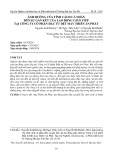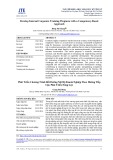
FTU Working Paper Series, Vol. 1 No. 3 (06/2021) | 45
ẢNH HƯỞNG CỦA NGUỒN GỐC FDI ĐẾN
TÌNH HÌNH VIỆC LÀM TẠI VIỆT NAM
Bùi Tùng Dương1, Nguyễn Phương Thảo, Lê Hồ Anh Thư
Sinh viên CTTT KT - K57 – Viện KT & KDQT
Trường Đại học Ngoại thương, Hà Nội, Việt Nam
Vương Hiển Minh
Sinh viên KTĐN – K57 – Viện KT & KDQT
Trường Đại học Ngoại thương, Hà Nội, Việt Nam
Cao Thị Hồng Vinh
Giảng viên Viện Kinh tế và Kinh doanh Quốc tế
Trường Đại học Ngoại thương, Hà Nội, Việt Nam
Tóm tắt
Trong bài viết này, chúng tôi tập trung vào những câu hỏi sau: Ảnh hưởng của FDI lên ba yếu tố
của người lao động bao gồm tiền lương, lượng công việc tạo ra và lợi ích bảo hiểm? Nguồn gốc của
FDI có ảnh hưởng đến mối quan hệ trên hay không? Nếu có, ảnh hưởng như thế nào? Dữ liệu điều
tra doanh nghiệp tại Việt Nam năm 2017 và 2018 được phân tích sử dụng mô hình tác động cố định.
Chúng tôi nhận thấy khi kiểm soát tương tác giữa tỷ lệ yếu tố nước ngoài và biến kiểm soát, ảnh
hưởng của FDI lên lao động trở nên đáng kể. FDI có xu hướng làm tăng lương trung bình và giảm
số lượng việc làm tạo ra cũng như số lượng lao động được nhận bảo hiểm. Xét thêm yếu tố nguồn
gốc nguồn vốn đầu tư, ảnh hưởng của FDI lên lao động là khác nhau khi FDI đến từ các quốc gia
khác nhau, tương tự như kết quả các nghiên cứu trước.
Từ khóa: FDI, nguồn gốc FDI, Lao động, Tiền lương, Việc làm, Lợi ích bảo hiểm
THE EFFECT OF FDI ORIGIN ON
ASPECTS OF EMPLOYMENT IN VIETNAM
Abstract
In this paper, we focus on these questions: What are FDI effects on three aspects of employment
including wage, job creation and insurance benefits? Could country of origin moderate these
effects? And if it could, to what extent could it affect? Firm level data in Vietnam are analyzed for
2017 and 2018 using fixed-effects model. We find that when controlling for the interaction between
foreign share and control variables, FDI impacts on employment aspects change from insignificant
1 Tác giả liên hệ, Email: tungduongbui167@gmail
Working Paper 2021.1.3.04
- Vol 1, No 3

FTU Working Paper Series, Vol. 1 No. 3 (06/2021) | 46
into significant. FDI exerts an upward trend on the average wages and a downward trend for jobs
created and the number of workers receiving insurance. Regarding to country of origin, these
impacts on employment factors vary across FDI source, corroborating previous studies.
Keywords: FDI, FDI origin, Employment, Wage, Job, Insurance benefit.
1. Introduction
Foreign direct investment (FDI) is defined as a form of international capital movement with the
purpose of establishing and maintaining permanent equity relations with the foreign company at
the same time to exercise a noticeable influence on the management of the company
(Golejewska, 2002). Despite being perceived as a source of foreign influence and of competition
with local enterprises (Blomstrom et al.,1997), the attraction of foreign investors is still an
important goal of policy makers worldwide, especially in less developed countries where lack
of capital is one of the key constraints to economic prosperity (Coniglio et al., 2015).
The dramatic increase in FDI flows throughout the globe has led to the attention on its impact
on the host countries (Ni et al., 2017). In the field of International Business, a lot of empirical
studies have been devoted to understanding the effects of foreign investors on host countries’ wage
and employment; yet, the results of these studies are mixed and their evidence is still far from
conclusive. The divergence in empirical findings can be partly attributed to the methodological
issues and the characteristics of the host countries, industries and firms (Fortanier, 2007).
However, one factor that contributes to the relationship between FDI and host countries' wage and
employment have so far received little attention: the heterogeneity of FDI itself (Chen, 2011).
In the field of Economics, FDI is usually assumed as homogeneous flows of capital, thus, the
wage and employment effects are the same for all types of FDI. Rather, FDI differs by various
characteristics, such as by the size and entry mode, the role in the global value chain, the aim of
investment... but mostly related to firm performances (Chen, 2011). This article examines whether
the heterogeneous characteristics of FDI in empirical study enhances our understanding of the
impact of FDI: i.e. whether and to what extent the origin of investors affects the wage and non-
wage rate and the job creation rate of the host economies.
In this study, we focus on the role of one characteristic of FDI: its country of origin. Early
research proves that the FDI country of origin’s market conditions, business and institutional
systems (Whitley, 1998) have substantial influences on the strategic and organizational
characteristics of multinationals including human resource management practices (Bae et al.,
1998). Therefore, we form a hypothesis that FDI from different countries should also have
different wage, non-wage and employment effects on the host nations.
To test this and contribute further to the literature, we investigate an important emerging
economy, Vietnam. Since the late 1990s, Vietnam has experienced a significant surge inward
foreign direct investment (FDI) owing to the adoption of a major economic reform known as Doi
Moi in 1986 followed by enactment of the Law on Foreign Direct Investment in 1987 and its
accession to the World Trade Organization (WTO) in 2006. The rapid growth in inward FDI to
Vietnam has a positive impact on the registered foreign capital (GSO, 2017) and net export (Anwar
and Nguyen, 2011), thus leading to the increase in economic growth (Hoang et al., 2010; Vu et
al., 2008).

FTU Working Paper Series, Vol. 1 No. 3 (06/2021) | 47
We study the effect of FDI and FDI origin on three aspects of employment in Vietnam
including wage, job creation and insurance. Although a few studies have examined FDI effects on
wage and employment in Vietnam (Nguyen, 2019; Hoi & Pomfret, 2010), this paper provides
some of the first findings on the differences in the effects of FDI level on wage, job and insurance
of domestic firms under the perspective of investor origin heterogeneity. The findings from this
paper are expected to have significant implications for evaluating and selecting the suitable foreign
investors to attract based on their impact on domestic firms' employment and the economy at large.
The following empirical analyses employ a firm-level dataset in over 2000 industries in
Vietnam during a two-year period from 2017 to 2018. The data were obtained from comprehensive
surveys commissioned by the General Statistics Office of Vietnam (GSO), including
questionnaires collecting information on enterprises in Vietnam including State enterprises, non-
state enterprises, enterprises that have foreign investment, cooperatives/consortium cooperatives.
The rest of the paper is structured as follows. Section 2 reviews the literature on effects of FDI
and FDI origin on employment. Section 3 specifies the method of data collection, empirical model
and dataset description. Section 4 presents empirical results and relevant analyses. Finally, Section
5 gives concluding remarks.
2. Literature Review
The literature regarding FDI and its effect on host countries’ employment has been well
documented. In this section, we summarize the effect of foreign ownership and FDI origins on
host countries’ employment including wage, job and insurance as well as the moderating effect of
country of origin that have been so far taken into consideration.
2.1. The wage effects of FDI and its country of origin.
2.1.1. FDI Wage effects
There is a large body of literature on the wage effect of foreign investment in host countries,
broadly classified into two main grounds: (1) foreign wage differentials and (2) foreign wage
spillover (Brown et al., 2003; Lipsey, 2004). Regarding the former, empirical evidence suggests
that foreign firms pay higher wages than their domestic counterparts within host countries, within
industries and regions in these countries even after detailed differences in firm characteristics like
capital intensity, size, location, industry features and educational level of workers are taken into
account (Conyon et al., 2003, Görg et al., 2007; Huang et al., 2017). Studies conducted in
developed countries estimate that average wages paid by foreign establishments are approximately
6-22% higher in the United States (Feliciano & Lipsey, 2006; Lipsey, 1994) and 4-26% higher in
the United Kingdom (Conyon et al., 2002; Driffield & Girma, 2003; Girma et al., 2001).
Similarly, the foreign wage premia are also proved to exist and even emphasized to be higher
in developing countries (Egger & Kreickemeier, 2013). In Indonesia, the average wage in foreign
plants is about 50% higher than in private local plants and 60% higher including other types of
labour compensation, such as bonuses, gifts, social security, insurances and pensions (Lipsey &
Sjöholm, 2004). In Venezuela and Mexico, wages in foreign-owned manufacturing establishments
are higher than in domestically owned establishments by 30% (Aitken et al., 1996).
Whilst wage gap estimates between foreign and domestic firms are consistent across existing
literature, the explanations for such results are varied. One common reasoning is that foreign

FTU Working Paper Series, Vol. 1 No. 3 (06/2021) | 48
investors pay higher wages in order to reduce worker turnover and thus, to minimize the risk of
technology and knowledge diffusion through labour mobility (Fosfuri et al., 2001; Glass & Saggi,
2002, Aitken et al., 1996, Balsvik, 2011; Poole, 2013). Other authors have argued that
multinational enterprises offer higher wages to compensate for the possible disadvantages of
employment in an MNE, for example, greater pressure and labor demand volatility (Fabbri et al.,
2003; Gorg & Strobl, 2003), or higher foreign plant closure rate (Javorcik, 2015). Another
motivation for higher wages paid by foreign affiliates can also be explained by rent-sharing across
international borders (Budd & Slaughter, 2004) and between employers and employees (Budd et
al., 2005).
The second strand of studies on the FDI-linked wage effect focuses on the impact of foreign
ownership on the wage rate and wage growth of domestically owned firms. Theoretical studies
show that FDI wage spillovers to domestic firms may be generated through several channels. The
presence of foreign ownership may lead to positive wage spillovers due to the increasing
competition in the labour market. This shifts up the labor demand curve and thus, obliges local
firms to increase their wage rates to attract and retain workers, especially high-skilled labour
(Aitken et al., 1996). Technological spillovers are also an important channel of FDI wage
spillovers. Technological externalities transferred through imitation/demonstration effect, labour
mobility or horizontal and vertical linkages (Crespo & Fontoura, 2007; Hoi & Pomfret, 2010) may
increase productivity and possibly, wage level of domestic firms (Javorcik, 2004; Görg &
Greenaway, 2004).
On the other hand, FIEs may recruit the best workers from domestic firms or acquire high
wage local firms, thus lowering the labor quality and the wage rate of local firms (Lipsey &
Sjöholm, 2004). Also, foreign participation in product markets may lead to lower scale of
production of domestic firms, reduce their market shares and even crowd them out (Aitken &
Harrison, 1999; Kosová, 2010).
The empirical evidence from existing literature shows mixed results of FDI wage spillovers.
Some authors prove that local workers are better off by FDI wage spillovers in a wide range of
countries, such as Indonesia (Lipsey and Sjoholm, 2004), The United Kingdom (Driffield &
Girma, 2003), The United States (Aitken et al., 1996), Poland (Bedi and Cieslik, 2002). Some
other researchers find negative effects of foreign presence on wage levels of domestic firms (Barry,
et al., 2005; Hu & Jefferson, 2002). Finally, some studies find no evidence of wage spillover from
FDI to domestic establishments, for example, in the United States (Feliciano & Lipsey, 2006), in
Mexico and Venezuela (Aitken et al.,1996), and in the United Kingdom (Girma et al., 2001).
2.1.2. Wage Effects of FDI Country of origin.
A growing body of research has been done to examine the moderating effect of country of origin
on FDI linked wage effects, returning mixed results. In brief, these papers show that FDI origin
may play an important role in determining wage impact of FDI.
In the UK, Girma & Görg (2007) find evidence for significant positive wage effects resulting
from acquisitions from US companies, however, EU counterparts may not bring any impact. In
China, Liu et al. (2015) argue that while takeovers from North America and Europe put an upward
effect on wages, this seems negligible for HMT (Hongkong, Macau, Taiwan) and JKS (Japan,
Korea, Singapore) subsamples. This is maybe because North American and European acquirers

FTU Working Paper Series, Vol. 1 No. 3 (06/2021) | 49
possess higher technological intensity thus avoiding labor turnover related technology diffusions
by paying premium.
Similarly, the studies on sub-Saharan African firms return findings supporting the moderating
impact of parents origin (Coniglio et al., 2015; Blanas et al.,2019). In terms of development level,
MNEs from developed countries may be correlated with higher average wages than those from
less-developed counterparts (Coniglio et al., 2015). Relating to geographic area, the average wages
paid by Chinese investors seems lower than other counterparts as Chinese MNEs may highly
demand low-quality workers, thus offering lower wages and/or compared with others, their
locations tend to be remote from urban areas taking less labor costs (Coniglio et al., 2015).
Meanwhile, Blanas et al. (2019) argue that those from outside sub-Saharan Africa may pay higher
than local counterparts, regardless of labor type. However, these results for those from sub-Saharan
Africa seem true for only managerial and non-production laborers.
In sum, the impact of FDI source on FDI wage effects has increasingly grabbed scholars’
attention with diverse findings supporting that a heterogeneity of FDI induced wage effect may
come from the difference of FDI origins. However, in Vietnam it still has been negligibly
considered and we expect that the wage impact of FDI differs by FDI source.
2.2. Job creation effects of FDI and its country of origin
2.2.1. FDI Job creation effects
Employment creation has been regarded as one of the potential contributions of inward FDI to host
countries. However, most analyses on the influence of FDI on employment identify both positive
and negative potential effects (Jenkins, 2006; Rama, 2003; UNCTAD, 1994). FDI can increase the
local labour demand directly by establishing new greenfield subsidiaries (Rama, 2003) or even
expanding existing ones (ILO, 1984). FDI can also lead to increased volume of employment
through spurring forward and backward linkages (Golejewska, 2002; Ernst, 2005; Liu et al., 2009).
These “crowding in” effects may endure if these foreign firms make long-term commitments to
the host countries.
On the other hand, there is evidence that FDI also generates negative effects on host
economies' employment (Jenkins, 2006; Rama, 2003; UNCTAD, 1994). FDI may crowd out non-
competitive local firms, leading to job losses for the host economies. According to Jenkins (2006),
the reduction in volume of employment may also be associated with FDI involving the acquisition
of local firms and application of labour-saving technologies. Moreover, as multinationals are
footloose and able to relocate production and employment between their affiliates in different
countries, jobs created are likely to be highly unstable.
There is a number of empirical literature on the effect of FDI on employment creation in
both developed and developing countries. Most of the findings about developed countries point
out that firm-level employment remains unchanged or increases after foreign acquisition, for
example in the UK (Girma, 2005), Sweden (Bandick & Karpaty, 2007), Norway (Balsvik &
Haller; 2010). Studies about developing countries show that foreign firms, on average, grew
more rapidly (Lipsey et al., 2010) and have larger numbers of workers than domestically owned
firms (Barthel et al., 2011).
2.2.2. Job creation effects of FDI Country of origin.


























